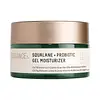What's inside
What's inside
 Key Ingredients
Key Ingredients

 Benefits
Benefits

 Concerns
Concerns

 Ingredients Side-by-side
Ingredients Side-by-side

Water
Skin ConditioningMethylpropanediol
SolventCoconut Alkanes
EmollientAlcohol Denat. Sd Alcohol 40
SolventGlycerin
HumectantCetearyl Alcohol
EmollientZea Mays Starch
AbsorbentAloe Barbadensis Leaf Juice
Skin ConditioningLauroyl Lysine
Skin ConditioningGaultheria Procumbens Leaf Extract
PerfumingEpilobium Angustifolium Flower/Leaf/Stem Extract
Skin ConditioningMalic Acid
BufferingBehenyl Alcohol
EmollientCoco-Caprylate/Caprate
EmollientXanthan Gum
EmulsifyingSodium Hydroxide
BufferingAllantoin
Skin ConditioningPhenoxyethanol
PreservativeZinc Gluconate
Skin ConditioningHydroxyethyl Acrylate/Sodium Acryloyldimethyl Taurate Copolymer
Emulsion StabilisingWater, Methylpropanediol, Coconut Alkanes, Alcohol Denat. Sd Alcohol 40, Glycerin, Cetearyl Alcohol, Zea Mays Starch, Aloe Barbadensis Leaf Juice, Lauroyl Lysine, Gaultheria Procumbens Leaf Extract, Epilobium Angustifolium Flower/Leaf/Stem Extract, Malic Acid, Behenyl Alcohol, Coco-Caprylate/Caprate, Xanthan Gum, Sodium Hydroxide, Allantoin, Phenoxyethanol, Zinc Gluconate, Hydroxyethyl Acrylate/Sodium Acryloyldimethyl Taurate Copolymer
Water
Skin ConditioningGlycerin
HumectantSqualane
EmollientLepidium Sativum Sprout Extract
Skin ConditioningSodium Acrylates Copolymer
Caprylic/Capric Triglyceride
MaskingBisabolol
MaskingPhospholipids
Skin ConditioningHansenula/Kloeckera/Lactobacillus/Lactococcus/Leuconostoc/Pediococcus/Saccharomyces/Fig/Lemon Ferment
Skin ConditioningSodium Hyaluronate
HumectantChondrus Crispus Extract
Skin ConditioningAllantoin
Skin ConditioningGlycine Soja Sterols
EmollientLinoleic Acid
CleansingCapryloyl Glycerin/Sebacic Acid Copolymer
Skin ConditioningDiheptyl Succinate
EmollientCellulose Gum
Emulsion StabilisingLecithin
EmollientSorbitan Oleate
EmulsifyingIsoeicosane
EmollientChitosan
Sodium Phytate
Caprylyl Glycol
EmollientPhenoxyethanol
Preservative1,2-Hexanediol
Skin ConditioningCitric Acid
BufferingWater, Glycerin, Squalane, Lepidium Sativum Sprout Extract, Sodium Acrylates Copolymer, Caprylic/Capric Triglyceride, Bisabolol, Phospholipids, Hansenula/Kloeckera/Lactobacillus/Lactococcus/Leuconostoc/Pediococcus/Saccharomyces/Fig/Lemon Ferment, Sodium Hyaluronate, Chondrus Crispus Extract, Allantoin, Glycine Soja Sterols, Linoleic Acid, Capryloyl Glycerin/Sebacic Acid Copolymer, Diheptyl Succinate, Cellulose Gum, Lecithin, Sorbitan Oleate, Isoeicosane, Chitosan, Sodium Phytate, Caprylyl Glycol, Phenoxyethanol, 1,2-Hexanediol, Citric Acid
 Reviews
Reviews

Ingredients Explained
These ingredients are found in both products.
Ingredients higher up in an ingredient list are typically present in a larger amount.
Allantoin is a soothing ingredient known for its protective and moisturizingg properties. Because of this, it is often added to products with strong active ingredients.
Studies show higher concentrations of this ingredient can promote wound healing.
Though it can be derived from the comfrey plant, allantoin is produced synthetically for cosmetic products to ensure purity.
Learn more about AllantoinGlycerin is already naturally found in your skin. It helps moisturize and protect your skin.
A study from 2016 found glycerin to be more effective as a humectant than AHAs and hyaluronic acid.
As a humectant, it helps the skin stay hydrated by pulling moisture to your skin. The low molecular weight of glycerin allows it to pull moisture into the deeper layers of your skin.
Hydrated skin improves your skin barrier; Your skin barrier helps protect against irritants and bacteria.
Glycerin has also been found to have antimicrobial and antiviral properties. Due to these properties, glycerin is often used in wound and burn treatments.
In cosmetics, glycerin is usually derived from plants such as soybean or palm. However, it can also be sourced from animals, such as tallow or animal fat.
This ingredient is organic, colorless, odorless, and non-toxic.
Glycerin is the name for this ingredient in American English. British English uses Glycerol/Glycerine.
Learn more about GlycerinPhenoxyethanol is a preservative that has germicide, antimicrobial, and aromatic properties. Studies show that phenoxyethanol can prevent microbial growth. By itself, it has a scent that is similar to that of a rose.
It's often used in formulations along with Caprylyl Glycol to preserve the shelf life of products.
Water. It's the most common cosmetic ingredient of all. You'll usually see it at the top of ingredient lists, meaning that it makes up the largest part of the product.
So why is it so popular? Water most often acts as a solvent - this means that it helps dissolve other ingredients into the formulation.
You'll also recognize water as that liquid we all need to stay alive. If you see this, drink a glass of water. Stay hydrated!
Learn more about Water